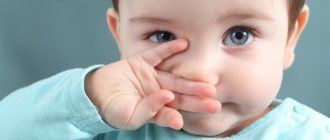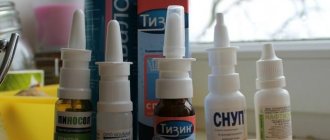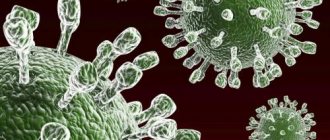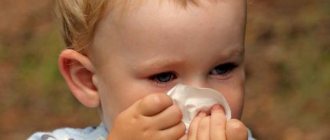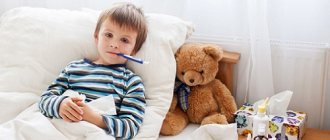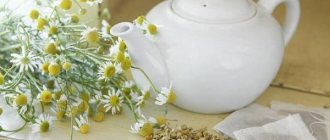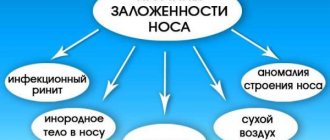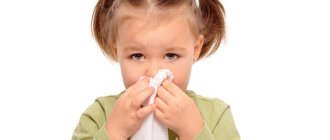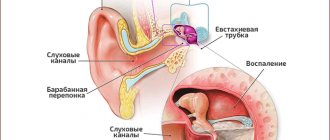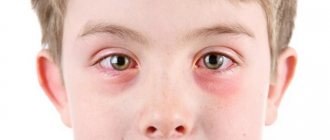The child has yellow snot
The snot of a sick child is at first liquid and mucous, then it becomes cloudy, thickens, turns yellow - all this under conditions of complete waste. The color of a runny nose, in other words, is an indicator of the intensity of inflammation.
Yellow snot in a child indicates a struggle of the immune system against pathogens that have entered the body through the respiratory tract. This shouldn't worry parents too much. Yellowish snot in the case of an uncomplicated infection is an indicator of the final stage of the disease.
Snot contains water, salts and mucin - a protein on which the thickness of the mucus depends. The more there is, the thicker the secret becomes.
If a runny nose is not accompanied by a deterioration of the condition and ends with the formation of yellow snot, we can talk about recovery. If a fever occurs and a decrease in the child’s activity is observed a week after the illness, then this is an indicator of the neglect of the process, requiring urgent treatment.
Causes
Yellow snot in a child can be associated with various reasons:
- Viral infection (usually adenovirus), allergic manifestation, hypothermia.
- Congenital or acquired defects of the nasal septum - they always increase the secretory function of the nose. If mucus stagnates, bacteria begin to multiply in it.
- Injury to the nasal mucosa when a child inserts various small objects into it. In response to injury, pockets of inflammation appear in the nose with increased secretion.
- Against the background of a prolonged runny nose, more than 7-10 days, yellow-green snot indicates complications. This means the penetration of pathogenic microflora into the internal sinuses and the development of sinusitis. Then the mucous membrane swells, nasal congestion, fever, headaches, and mouth breathing appear.
- Until the age of 5 years, the circulatory system of the nasal mucosa is formed in the baby; the vessels can sometimes burst. Then the blood components mix with nasal discharge and give a yellow-brown tint. Nosebleeds occur quite often before age 5.
- If the allergic rhinitis is chronic, sniffing leads to the penetration of snot deep into the nose, where the mucus stagnates. Then it thickens and changes color.
- Dry air in the room dries out the mucous membrane and the body increases its secretion to moisturize it. Microbes try to multiply on the mucous membrane, die, and the color of the secretion changes.
- Bright yellow discharge appears with sinusitis - it dries out and forms crusts.
- In infants, colored, thick sniffles appear after hypothermia or infection from adult family members.
- The growth of adenoids also provokes the secretion of thick, light yellow mucus. Such diseases are common from 2 to 5 years.
Do I need to treat a runny nose?
The yellow-green secretory fluid secreted from the nose is the body's natural defense mechanism. If certain conditions are met, which we will discuss below, a runny nose goes away on its own within two to three weeks, as the immune system fights the infection.
Many parents rush to treat yellow snot in their child because they believe that a bacterial infection has been added to the virus. However, active therapy can be unnecessary or even dangerous when it comes to antibiotics, so before taking measures to relieve a runny nose with medication, make sure that:
- the baby has a fever;
- the child feels unwell;
- refuses to eat or drink;
- complains of headache;
- the illness lasts more than four days.
The presence of these symptoms is a reason to consult with your doctor, who will help you choose the optimal treatment in accordance with the exact diagnosis.
In fact, the question of how to treat a runny nose is incorrect. Cloudy, stringy, green, yellow nasal discharge is a symptom of a viral or bacterial infection, and it is this that needs to be treated. By acting locally on the mucous membrane of the nasal sinuses, parents relieve symptoms by interfering with the functioning of the baby’s immune system. Most often, a runny nose is a companion to viruses, which, according to evidence-based medicine studies, cannot be cured by any of the known pharmaceuticals.
Medicines prescribed for ARVI play the role of a kind of “sedative” for anxious parents. The common treatment of a runny nose with vasoconstrictor, antibacterial, antiviral, and immunomodulatory drugs is untenable.
Rinsing the nasal sinuses also needs to be done with extreme caution - an incorrect procedure can lead to otitis media. In addition, the saline solution washes out not only harmful bacteria, but also beneficial antimicrobial organisms. Research by American doctors has shown that regular nasal rinsing for 12 months, with further refusal of this manipulation, leads to an increase in sinusitis by more than 60%.
Antibiotics should only be prescribed to a child by a doctor after appropriate tests. This group of drugs destroys the gastrointestinal microflora and can also cause a serious allergic reaction. The limited spectrum of action increases the likelihood of an erroneous choice - the medicine will not work, and the harmful consequences for the intestines will still have to be eliminated. Please note that you cannot interrupt the course of antibiotics.
What are the dangers and possible complications?
Yellow snot is often a sign of recovery, but since there is an infectious process present, if it is not treated correctly there can be complications. This is especially dangerous in children under 3 years of age. If discharge accumulates in the sinuses, it can lead to:
- development of chronic runny nose;
- nasal polyposis with decreased sense of smell;
- sinusitis, sinusitis;
- bronchitis.
In infants, prolonged snot easily provokes pneumonia, and after 2 years - asthma.
Swelling of the nasal mucosa can spread to the throat and ears. The consequence is laryngitis, pharyngitis or otitis media. If there is no treatment in this case, the pathogens descend further, affecting the internal organs.
Less commonly, bacterial rhinitis leads to eye diseases: dacryocystitis - inflammation of the lacrimal canal.
Consequences of lack of treatment
The nasal passages of newborns and babies of the first year of life have a very narrow clearance, compared to adults.
If nasal mucus is not removed from there in time - with cotton swabs or by rinsing - it will fall on the back wall of the throat, flowing down it. In this case, you need to remember - snot is a reservoir of infection. Infectious agents - viruses and bacteria - are constantly present and multiplying there. Flowing together with mucus, they get the opportunity to get into the throat and cause laryngitis, tonsillitis, pharyngitis, or get into the lower parts of the respiratory tract - the trachea and bronchi, causing an inflammatory process there too. Stagnation of snot leads to a local response - swelling of the nasal mucosa and nasal passages. The complex of these complications leads to the baby refusing the breast, if he is breastfed, or the bottle - while eating, he will constantly choke on milk. Because of this, the baby may begin to lose weight.
In addition, due to the constant accumulation of mucus in the nose, it can enter the Eustachian tube - a direct path to the ear. If pathological contents in the form of yellow snot enter the cavity of the eardrum, otitis media develops, which is also dangerous for the baby’s health by rupture of the membrane and inflammation of the temporal bone like osteomyelitis. It is worth noting that otitis media is a painful process; children with this pathology may experience sleep disturbances and anxiety.
Yellow snot can also cause adenoiditis, an inflammatory phenomenon in the lymphoid tissue of the pharynx. In this case, this symptom may be accompanied by a dry cough, and in the absence of help, the child’s facial features change (adenoid face).
Often yellow snot indicates the development of sinusitis in the baby’s respiratory organs - then the paranasal sinuses are involved in the pathological process, most often the maxillary sinuses. These conditions develop because the outflow of the mucous membrane is impossible due to swelling of the ducts of the maxillary sinus. Once in a closed space, bacteria actively multiply, which, in addition to yellow snot, causes intoxication, fever, and loss of appetite. Consultation with a specialist is necessary - sinusitis is a dangerous disease, especially for this age. Pus from the maxillary sinus can enter the eye socket and brain - then surgical treatment is resorted to.
A symptom such as yellow snot in newborns may indicate the formation of a cavity with liquid contents - a cyst - or a tumor. Mucus is released when the cyst shell bursts and the contents exit into the nasal passage.
Treatment of yellow snot in a child
In any case, treatment must be prescribed by a doctor.
For allergic manifestations, it is useful to rinse the nasal cavity with saline solution, aerosol sprays based on sea water, and antihistamines.
For acute respiratory infections, it is necessary to use vasoconstrictor drops (preferably no later than 2-4 days after detecting signs of a cold). Noxprey and Naphthyzin drops are most often used, Vibrocil and Nazivin are used for children under one year of age. Vasoconstriction relieves swelling, facilitates breathing and prevents complications from developing. For the little ones, you can use harmless Protargol and Sialor. They make breathing easier, improve the patency of the Eustachian tube and prevent the development of otitis media.
From 2 years of age, Snoop Baby and Tizin drops and sprays are recommended for children. From 3 years - Bioparox spray. They treat the nose and throat.
Another drug is Isofra. Contains the antibiotic framycetin. Release form: nasal drops for the youngest and sprays for older children.
Komarovsky does not encourage the use of antibiotic drops.
Pinovit and Pinosol perfectly soften the mucous membranes and have a natural composition of essential oils. They are antiseptics and reparants.
Antibiotics and medications that enhance immunity are often prescribed.
In order for the drops to show their effect and reach the mucous membrane, the nose must first be cleared of mucus.
For infants, snot is removed with a small pear, lightly greasing its tip with Vaseline. When the pear is unclenched, it draws in snot with a characteristic gurgling sound. Using a pharmacy aspirator or nozzle ejector is, of course, more convenient and hygienic.
For older children, their noses are washed with saline solution - Furacilin, Chlorhexidine, Miramistin. This can also be done with drops of sea salt: Aqualor, Aqua Maris, AquaMaster, Aqua-rinosol, Dolphin, Quicks, Nazol aqua, Rizosin, Salin, Sialor aqua, Physiomer, Humer.
Washing must be done correctly, otherwise otitis media may develop. Packages of pharmaceutical solutions always contain instructions for rinsing the nose.
Treatment with folk remedies
Folk remedies also have the right to be used, but only after consultation with a doctor - this is the rule. They are not prescribed in the acute period.
Most popular recipes:
- Herbal infusions: calendula, chamomile, St. John's wort, sage. They are used to rinse the nose or make inhalations.
- Drops: beet juice, Kalanchoe, aloe. They are diluted in half with warm boiled water. Instill 1-2 drops 2 to 3 times a day.
- Essential oils: eucalyptus, thuja, etc. They are instilled 1 drop several times a day. It is better to purchase oils at a homeopathic pharmacy, here they are more purified.
- Oil emulsions and propolis tinctures. They are not only antiseptic, but also help relieve swelling.
- To eliminate yellow snot from schoolchildren, drops are made. The recipe is simple - mix olive oil, onion and garlic juice in equal proportions.
- Aloe juice heals and softens runny nose. 1 drop per day is enough.
- Aroma lamp with eucalyptus and tea tree oil. These substances have an antimicrobial effect. But the baby’s contact with essential oils should be short, otherwise headaches cannot be avoided.
Drug treatment
If yellow snot appears in infants, you cannot treat it yourself, as this can lead to serious complications and become life-threatening for the baby. It is necessary to consult a doctor for examination and treatment.
The doctor, having determined the cause and type of the disease, prescribes comprehensive treatment, including:
- rinsing the nose to thin accumulated mucus and make it easier to eliminate. You can rinse your nose with special saline solutions sold in pharmacies, saline solution or a weak chamomile decoction;
- vasoconstrictor drops, designed specifically for infants, are prescribed in the presence of a severe runny nose. When using them, it is recommended to additionally rinse with Aqualor or Aquamaris based on natural sea water, which will provide the necessary hydration to the nasal mucosa;
- antibiotics. Can be prescribed by a doctor in particularly difficult cases.
For preschoolers and schoolchildren, the choice of treatment method depends on the general condition of the child, the characteristics of the disease, its complexity and the consistency of the secreted snot. If the yellow snot is liquid and not accompanied by headaches and high fever, it does not pose any particular danger. In this case, you can rinse the nasal cavity with a pharmaceutical saline solution and instill vasoconstrictor drops.
Fighting colds and viral runny noses, which cause the formation of thick snot, is much more difficult, since the infection affects the child’s entire body, and not just the nasal cavity. In this case, there is a decrease in appetite, fever, weakness and headaches.
Treatment in this case will consist of:
- Reduce the temperature by wiping with cool water and applying vinegar compresses. The child is also advised to drink plenty of fluids. Help to bring down the temperature: fruit drinks made from raspberries, cranberries or black currants, tea with lemon and honey, chamomile infusion. Antipyretics should be given to a child only if the temperature rises above 38°.
- Instillation of drops that have a vasoconstrictor effect, but their use should not exceed 3-4 days, as they are addictive. The drops must be used according to the instructions.
- Carrying out inhalations using nebulizers or regular inhalation of steam from a boiled collection of anti-inflammatory herbs or essential oils of sea buckthorn, thuja and other coniferous trees.
If the use of such methods does not produce results within 4 days, you must consult a doctor to undergo examinations and find out how to properly treat the child in this case and what caused the deterioration of his condition.
Komarovsky's advice to parents
Vasoconstrictor drops should not be used for more than 5 days. Otherwise, they become addictive.
In addition to medications, the following measures are required:
- Carrying out regular wet cleaning of the premises.
- Limiting contact with sick children and adult family members;
- Mandatory hand washing after going outside.
- Maintaining the indoor microclimate is a humidity level of 60-70% at an air temperature of no higher than 22 degrees. In such cases, parents fear that the child will receive additional hypothermia, but this is not the case.
- Before going to bed, the child is dressed in thick pajamas made of breathable materials.
- Walking in the fresh air and ventilating the room where the patient is located are important.
Komarovsky does not recommend putting antibiotic drops into the nose or using Interferon and Oxolin.
Parents are also often interested in the question of instilling juices of beets, carrots, etc. into the noses of children. Answer: no juice cures a runny nose and does not contain beneficial substances for the nose. The same applies to dripping breast milk into the nose of infants.
Risk group
All children are different, but the causes of a runny nose are practically the same.
Newborns
A runny nose in a newborn is a terrible problem. The baby cannot breathe through his nose, it is difficult for him to suck the breast (bottle). The nasopharynx in a one-month-old baby is narrow and the passages are short, which is why they are quickly clogged with mucus. Snot in a newborn can be eliminated by a mother who does not neglect to consult a doctor.
If the mucus is caused not by illness, but by dust, then the nose of a month-old baby should be rinsed and the secretions removed using an aspirator or an enema, which can be purchased at a pharmacy.
Preschoolers
Why does thick yellow snot appear in children attending kindergarten (2-6 years old)? Frequent nasal discharge is a sign of weak immunity. Even a slight breath of wind causes a runny nose.
- Recommended reading: How to hover a child’s legs
For prevention, you should protect your baby from hypothermia:
- Dress according to the season:
- Check shoes for dryness (feet should be warm);
- Follow the diet (children's food should contain fish, meat, vegetables, fruits, dairy and fermented milk products);
- Physical activity should be calculated according to age. Overloading the body can also lead to a cold or runny nose (this is a protective reaction).
Pupils
A runny nose is observed in schoolchildren several times more often than in children. Treatment for older children is more difficult. Their body and immune system are not fully formed, so preventive measures should be taken to increase immunity.
The very first method of prevention is the prevention of colds and viral diseases. There is already a vaccine against the flu, so your child should be vaccinated a month before the outbreak. Take regular walks in the fresh air, wet cleaning and ventilation of rooms.
Most mothers do not pay attention to the color of the mucus discharged from the nose and immediately rinse it off, instead of starting timely treatment. But, if the runny nose lasts for 2-3 weeks, you need to go to an appointment with an ENT specialist. A prolonged runny nose can cause complications: sinusitis, sinusitis, otitis media. To prevent children from having problems with breathing and snot, perform a nasal toilet on time.
Prevention
The best prevention of seasonal colds is maintaining and strengthening the immune system in the form of hardening. You should dress your child according to the season, without wrapping him up, and monitor the dryness of his shoes. Nutrition and water and drinking regime must be at the proper level. Physical activity according to age is important, without overload.
Yellow snot is not always bad. More often than not, this indicates the end of the cold and should not cause concern for parents. But in the case of a prolonged runny nose, more than 2 weeks of snot is an indicator of the neglect of inflammatory processes. Physician supervision is necessary for any treatment experience.
